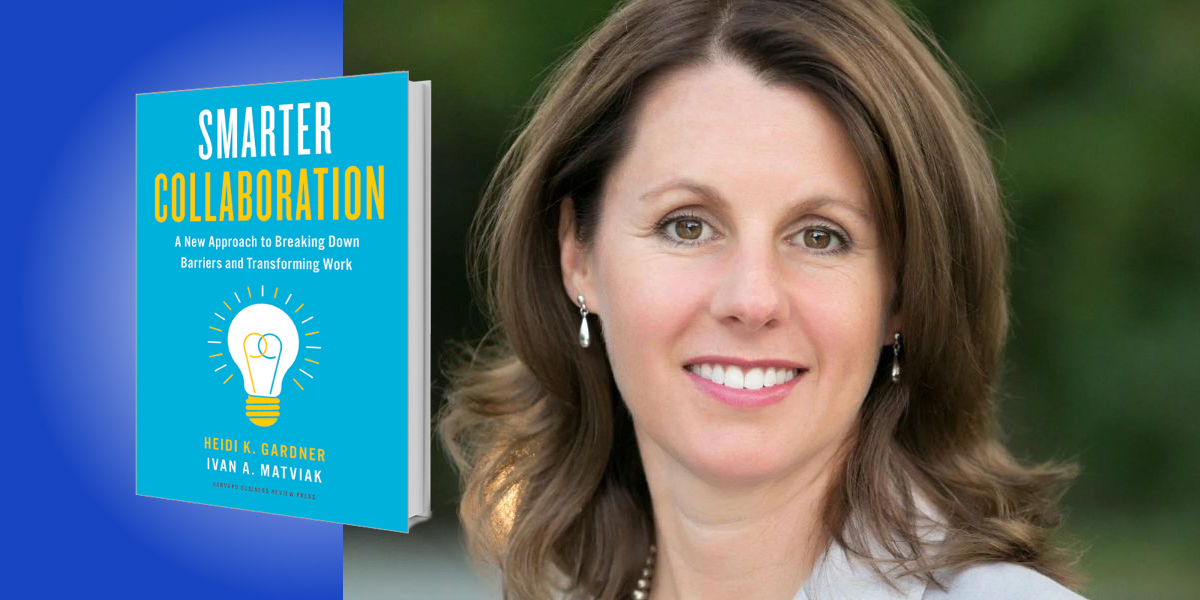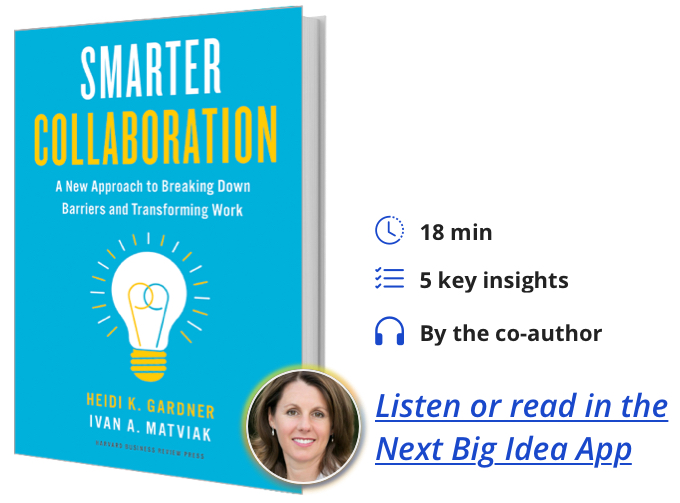Dr. Heidi Gardner is a Distinguished Fellow at Harvard Law School’s Center on the Legal Profession and Program Chair of the Sector Leadership Master Class and Smarter Collaboration Master Class.
Ivan Matviak is Executive Vice President at Clearwater Analytics.
Below, Heidi shares 5 key insights from their new book, Smarter Collaboration: A New Approach to Breaking Down Barriers and Transforming Work. Listen to the audio version—read by Heidi—in the Next Big Idea App.
1. Smarter collaboration drives quantifiable results.
We’ve collected millions of data records from organizations across the planet, across dozens of industries. Our empirical analyses demonstrate that smarter collaboration helps companies increase revenues and profits, generate longer-lasting and more lucrative client relationships, innovate faster, reduce enterprise risk, and attract, engage, and retain top talent.
But these days, our problems are so complex that the only way you get those hard outcomes is by bringing together different kinds of experts, and people with different life experiences. This is smarter collaboration. It’s a hyper-intentional way of starting with a problem, then dissecting it to figure out exactly who should be working on it, and for what inputs.
But it’s not enough just to bring diverse people together. You need leaders to create an environment where everybody feels empowered to speak up and contribute. A powerful example comes from Roche, a global biotech company with almost a 100,000 people. They radically streamlined the drug development process through more effective collaboration. The average time to get a drug through FDA approval was 21 months, which meant that sick people were waiting too long for innovative treatments. So Roche set out to radically shorten that time.
Their development process had been owned by three different groups. At each handover, from one part to the next, there was a very controlled approval stage, with people scheduling formal meetings, creating presentations, meeting again, and so on. It was slow and frustrating. Roche piloted cross-functional, cross-organizational teams to jointly work through every step from start to finish. They eliminated artificial organizational boundaries, stripped out the bureaucracy, and removed all the siloed approval processes. The new drug discovery process reduced time to FDA approval by 50 percent.
That kind of impact is not unusual for smarter collaboration. These days, everyone’s worried about engaging and retaining talent in a hybrid work model, and both companies and nonprofit organizations are getting similarly amazing results from smarter collaboration in this new environment.
2. Collaboration can be objectively analyzed for its effectiveness.
We’ve done research with more than 8,000 senior managers and companies, including biotech, banking, consumer products, energy law, and many others. There are common barriers within most organizations. For example, there are two critical kinds of trust. The first is competence trust. Am I confident in your capability to deliver high quality, on time, on budget, and add value? The other kind of trust is interpersonal trust. Do I trust your character? Do I believe you’re going to steal my ideas?
“Leaders tend to be out of touch.”
When we’re talking to big groups of executives, we nearly always hear a third type of objection, “I just don’t have time to collaborate.” There are ways to make collaboration more efficient, and the solutions hinge on a.) getting the incentives right so that people focus on collaborative outcomes and b.) making sure that people aren’t over committed on too many projects at once. But the typical barriers show up to a different degree in every company so it is important to assess what’s hindering your company, specifically, from smarter collaboration.
A final word of caution: Leaders tend to be out of touch. Almost nobody says no when a top leader asks them to get involved in a project. Plus, those leaders have spent a lot of time developing their internal networks to a degree that a lot of other people aren’t privileged to have. So, you need to collect the data, analyze it, and present it back in ways that leaders understand.
3. Most companies want collaboration. Most workers don’t feel encouraged to.
Narrow, short-term performance targets discourage collaboration. They make people scramble to hit their personal numbers and lose sight of the organization’s bigger objectives.
We worked, for example, with a fast-growing tech company that wrestled with the incentive problem. Every team that interacted with a new customer had their own set of incentives. The sales team was pushed to sell as much as possible. The implementation team was rewarded for installing as fast as possible. Individual customer service reps had metrics on the number of calls they handled per shift. Nobody was incentivized to make the overall experience positive for the client. Customers got so unhappy that the CEO heard about it.
Misaligned incentives kill collaboration. We developed a four-part scorecard to helps make sure that the Key Performance Indicators (KPIs) are focused on the customer and encourage collaboration within teams and across functions.
In the tech company we just spoke about, leaders revamped the incentives. They also realized that the overall performance management process was broken so they transformed their review system. They implemented pulse surveys to collect regular data instead of making appraisals an annual event. They trained managers on providing developmental feedback and a number of other changes.
4. More collaboration isn’t always better.
What you want is the right people at the right time, no more, no less. It’s especially dangerous when people get pulled across too many projects at the same time. There are some good reasons why people fall into the trap of overcommitment. Sometimes the work just outweighs the resources. Instead of thoughtfully stepping back and prioritizing, people get pulled into new projects without considering their current workload.
“There are some good reasons why people fall into the trap of overcommitment.”
When people end up stretched too thin across many initiatives the projects suffer because people can’t commit their full attention. When people are spread too thin, they have less impact, get burnt out, their engagement drops, and they might simply leave.
Two groups get hit hardest by this: stars and underrepresented groups. Stars tend to get pulled into everything. Underrepresented groups often end up overcommitted when a company sets goals of diversity on every project. Like if a company wants a woman on every project, but women are only a small fraction of the company.
Here are a few concrete steps for addressing overcommitment. First, make sure you are not the problem. If you’re staffing a project, don’t go straight to the usual suspects who are probably already overloaded. Seek out the hidden gems who might need exposure or a stretch opportunity. Also, stop heroizing busyness. Rather than people bragging about how many projects they’re involved with, get people focused on their impact.
5. The next frontier of smarter collaboration.
Imagine that you’ve assigned yourself a truly ambitious goal: save the oceans. What kinds of collaboration might get you there?
This was a core question faced by the father and son team of Ray and Mark Dalio. Ray founded Bridgewater Associates, an investment firm that grew into the world’s largest hedge fund. Along the way, Ray became a multi-billionaire with the resources to support selected philanthropies. One of the causes he chose was oceanographic conservation, a passion shared by his son, Mark. Together, in the spring of 2018, the Dalios launched OceanX. Their goal was to explore the ocean and bring it back to the world. Beyond pure science, their project has a second, equally important aspect of raising public awareness of the importance of the oceans and making people fall in love with this critical habitat.
To get there, they purchased a former oil support ship and retrofitted it to conduct serious research. Meanwhile, they entered a series of partnerships with respected research groups, such as Woods Hole Oceanographic Institute. A few years into its work, OceanX racked up impressive successes. The team was the first to explore the deep-sea floor of Antarctica, the first to tag a deep-sea shark from a sub, and the first to film a giant squid in the deep. They’ve discovered 180 new species of biofluorescent fish and have worked with NASA’s Jet Propulsion Lab to test equipment that one day might study oceans on other worlds.
OceanX’s second goal, advancing public awareness and education, requires collaboration between scientists and people in the creative community. Leonardo DiCaprio made a dive in one of OceanX’s subs for his documentary, Before the Flood. James Cameron, the celebrated director of Avatar and Titanic, is co-producing an ocean-focused documentary series with OceanX, BBC Studios, and National Geographic.
“People get excited when they can draw on their strengths to contribute to a bigger outcome than they could tackle alone.”
To accelerate collaboration between people with different backgrounds, OceanX partnered with tech companies like Microsoft. As Dalio said, “We partnered with Microsoft to use their augmented reality Mesh technology to visualize all of this data in a virtual environment onboard Ocean Explorer. We’re seeing the positions of the remote vehicles and subs, live feeds from cameras, and the topography of the sea floor all coming together in a holographic lab. This way, the scientists, ship crew, and media all participate and have their own visualizations of the data.”
Ranging even further afield, the collaboration has expanded to include companies like Crayola, the iconic maker of crayons. The two organizations share a common goal to educate young leaders through imagination and exploration and partnered to create co-branded products like home adventure kits, educational content, and events.
OceanX pushes the frontiers of smart collaboration by building an ecosystem of players with radically different expertise who are joined together by a common passion. As the world becomes more complex, addressing issues that fundamentally affect humankind requires unprecedented levels of investment over longer time horizons. Collaboration is evolving to meet those needs.
The big, thorny issues that warrant Smarter Collaboration are also the exact ones that give people a strong sense of purpose and meaning in their work. People get excited when they can draw on their strengths to contribute to a bigger outcome than they could tackle alone. Smarter collaboration improves people’s work lives, helps organizations achieve stronger and more strategic outcomes, and addresses some of society’s biggest challenges.
To listen to the audio version read by co-author Heidi Gardner, download the Next Big Idea App today:
































